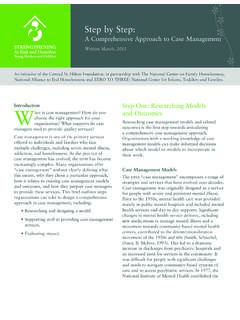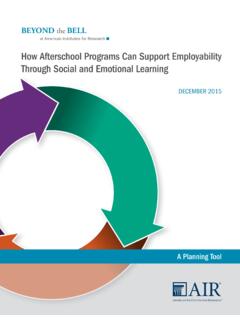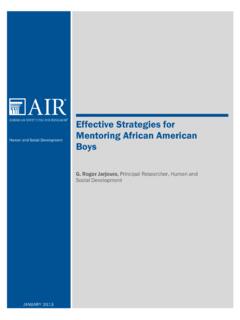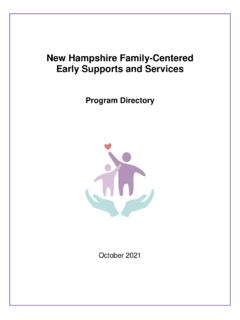Transcription of Teaching the Whole Child: Instructional Practices That ...
1 | Teaching THE Whole CHILD Instructional Practices That Integrate Equity- centered Social, Emotional, and Academic Learning AMERICAN INSTITUTES FOR RESEARCH THE Whole CHILDI nstructional Practices That Integrate Equity- centered Social, Emotional, and Academic LearningUpdated: Research-to-Practice Brief Nicholas Yoder, PhD Harmony SEL at National University Angela M. Ward, PhD Transforming Education, Center to Improve Social and Emotional Learning and School Safety at WestEd Sara Wolforth, JD American Institutes for Research The authors would like to thank the team at the Center on Great Teachers and Leaders at the American Institutes for Research who supported the development of the original brief in 2014.
2 The authors would also like the thank the following colleagues for their helpful reviews of this updated manuscript: Mara Schanfield and Jill Young at AIR, Natalie Walrond at the Center to Improve Social and Emotional Learning and School Safety at WestEd, and Richie Ressel at National of ContentsIntroduction 1 Understanding Social and Emotional Learning 3 Defining Social and Emotional Learning .. 3 Equity and SEL.
3 3 Importance of Social and Emotional Learning Integration .. 6 Instructional Practices That Promote Students Academic, Social, and Emotional Competencies 10 Practices That Promote Affirming Learning Environments .. 11 1. Warmth and Support (Educator and Peer)..12 2. Responsibility and Choice ..143. Youth- centered Problem Solving ..164. Power of Language ..17 Practices That Promote Learning Design and Instruction ..19 5. Cooperative Learning.. 20 6. Group Discussions .. 227. Self-Reflection and Self-Assessment.
4 248. Balanced Instruction .. 269. Expectations and Rigor.. 27 10. SEL Competence-Building Modeling, Practicing, Feedback, and Coaching .. 30 Conclusion and Action Steps 32 Selected Resources .. 33 References 36 Introduction Educators consistently see the ways in which students social and emotional development shows up in their learning environments when a student gets overjoyed for solving a math problem that challenged them or was able to use a mistake to propel learning.
5 Or when students dig into conversations with each other on the influence of media on their lives, identify solutions to pressing community problems, or lend another student a helping hand when they are down. While educators see social and emotional learning (SEL) play out in these contexts, they also have the opportunity to shape their students social and emotional development. Research confirms that educators not only have a significant impact on student academic learning (Chetty et al., 2011; Nye et al., 2004), but they also influence student social and emotional development. When students engage in SEL, they develop the social and emotional competencies ( , skills, attitudes, and knowledge) needed to be ready for and successful in college, careers, and life.
6 Such competencies include understanding oneself, collaborating with others, reflecting on personal and collective actions, and making responsible decisions (Durlak et al., 2011; Mahoney et al., 2018; Taylor et al., 2017). Educators can support and facilitate the development of these social and emotional competencies through modeling and meeting students where they are, ensuring that students are able to use these competencies as tools for personal and group self-reflection and knowledge acquisition. Social and emotional competencies are more important now than ever. After major disruptions to learning, particularly for those who are most marginalized, SEL will be even more critical to facilitate student healing, connection, and learning (Hamilton & Gross, 2021).
7 When educators implement SEL with intent and within affirming learning environments, they set students up for success as they meet the demands of engaging in deeper learning and rigorous instruction (National Governors Association Center for Best Practices & Council of Chief State School Officers, 2010a, 2010b). Providing opportunities for students to build their capacities and use their competencies is central to the co-construction of identity-affirming learning spaces for all youth (Jennings & Frank, 2015; Jones et al., 2013; Yoder, 2014b). To ensure student success, educators often engage in SEL work during regular instruction; however, it may not always be explicit or intentional (Yoder, 2013).
8 To elevate ways in which SEL is embedded in the work that educators are already doing, educators need culturally and linguistically sustaining scaffolds through protocols and processes to integrate SEL into existing Instructional Practices and educator professional learning systems. To maximize explicit SEL instruction, integration of SEL allows educators and students to move away from the traditional compartmentalized SEL time to an understanding that SEL is a core ingredient to Teaching and learning in identity-affirming spaces. Researchers and practitioners have already made promising progress in understanding and supporting SEL and academic integration, including work from, for example, the National Commission on Social, Emotional, and Academic Development Important Note In addition to this brief, updated versions of the aligned educator self-assessment tool, Self-Assessing Social and Emotional Instruction and Competencies,as well as the Social andEmotional Learning CoachingToolkit are in development.
9 The original brief aligned the 10educator Practices to teacherevaluation frameworks. Thecurrent brief does not provideor update the alignment. Formore information about thealignment, please see theinitial brief, Teaching the Whole Child: Instructional PracticesThat Promote Social-Emotional Learning in Three TeacherEvaluation the Whole Child(NC-SEAD) (2019), the Science of Learning and Development (SoLD) Alliance (2020), Transforming Education (2020), Urban Assembly, and a host of other SEL programs (Jones et al., 2021). This brief refines pioneering work on the integration of SEL with academics and specifically addresses 10 educator Practices that promote social, emotional, and academic development (Yoder, 2014a).
10 Given the advancements in the field, particularly on culturally responsive sustaining Practices (Jagers et al., 2019), SoLD principles (SoLD Alliance, 2020), trauma-informed instruction (Guarino & Chagnon, 2018), healing- centered engagement (Ginwright, 2015) and adult SEL (Jennings & Greenberg, 2009), we have updated the Practices to reflect these principles and be more inclusive of the multiple spaces in which students learn and develop. Further, in our review of literature on SEL integration, we noticed substantive lists of alignments, example Practices , and broad approaches. To help clarify what integration means, we provide a taxonomy of SEL-academic integration that includes four categories.

















